Nobel award for Discovery of Molecular mechanism controlling the Circadian rhythm
Published by Nobel Assembly at the Karolinksa Institutet, Stockholm, Sweden : Three Americans - namely Jeffrey C. Hall, Michael W. Young and Michael Rosbash have won a 2017 Nobel Prize in Physiology or Medicine on October 2, for the discoveries on the mechanisms which control the organisms overall circadian responses to the light and dark.

Jeffrey C. Hall, Michael Rosbash, and Michael W. Young. (credit)
Why most people feel energized and mostly alert around 10:00 in the morning ? Surprizingly, there is something that guides us how we feel throughout the whole day which is known to be as Circadian Rhythm. This is a type of rhythm which occurs naturally and is built in the human body system , along with the plants and the animals.A man named Franz Hallberg was the first one to derive this latin words Circa - meaning about and dien - meaning day. So, this literally translates to the word meaning a day rhythm.
Life on earth has been adapting to the rotation and revolution of our planet.And even for many years, we have been knowing that the living organisms here including the humans have a internal , a biological clock which helps in anticipating and adapting to the regular rhythms of the day. The theory formulated by the three scientist while announcing the winner while in Stockholm on Monday, the committee of prize said the scientist made a crystal clear on how biological clock can fluctuate to make our behaviors and physiology much optimized !
So, how does this internal, biological clock actually work ?
Jeffrey C. Hall, Michael W. Young and Michael Rosbash discoveries have explained the animals, plants and even human adapting to the biological rhythm which is also synchronized with the Earth's revolutions.
After working with the fruit flies considering as a model organism, this years Nobel laureates has isolated a gene responsible for controlling the normal daily biological rhythms. Their research shows that this gene encodes a protein which gather within a cell during the night time. This then degrades in the day time. Successively, they even identified a additional protein component of this machine, exposing a mechanism which governs a self-sustaining clockwork inside the cell. This principle of biological clock can be formulated in every cells and this recognition is accomplished even in the multi cellular organisms including the human beings.
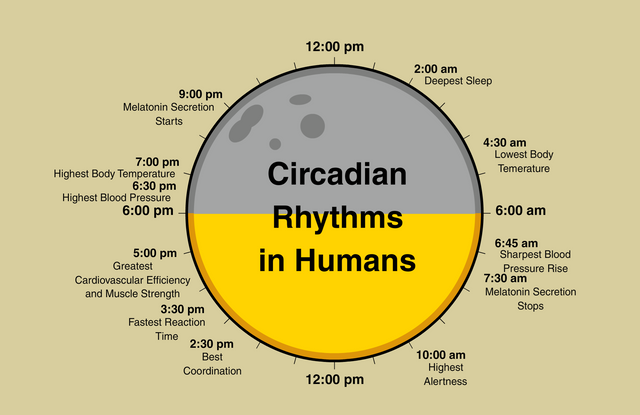
Fig: Circadian Clock (credit)
A extremely beautifully designed which to be exact, our biological inner clock adapts our physiology to different stages of our day. This clock even plays a great role in regulating our critical behaviours, hormonal levels, body temperatures , metabolisms and even some sleep. Our healthy body gets affected when there is a temporary mismatch among the internal biological clock and the external environment. Lets say for an example ; When we travel across the several and different time zones, there is an experience called as "jet lag" due to the misalignment in the clock.The is experienced in crisscrossing the time zones. Even experiencing different indicators of chronic misalignment between the rhythm dictated by our inner timekeeper and the lifestyles has a increased risk in various medical conditions and medical diseases.
Three scientists theorized that ; the brain has a single, a central clock which controls the cycles that we observe such as the rise and the fall of the blood pressure and temperature . And this goes in a different clock mechanism who survive without the brain.
Our Inner clock
Living organisms adapt to the daily changing environment. In the 18th century, A astronomer Jean Jacques d'Ortous de Mariran studied a plan type named mimosa plant. After studying this plant, he found that in the daytime, leaves of this plant just opened towards the sun whereas in the dusk,it closed. So he wondered and thought what would happen if the plant was placed in the constant darkness ? He formulated his experiment and found out that even though it was independent of the sunlight, the leaves opened and continued its daily oscillation. From this, it was considered that the plants have their own biological clock.
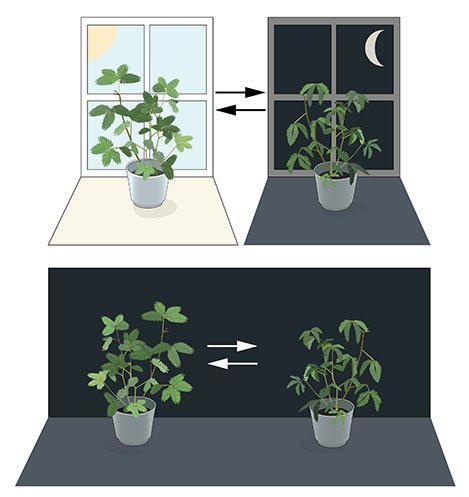
Fig: A biological clock in the mimosa plant (credit)
In the above picture, we can see a mimosa plant. The leaves of this plant open towards the sun during the daytime but closes during the night. After the experiment performed by the Jean Jacques d'Ortous de Mairan placing the plant in a constant darkness, it even though worked normally in the daily circadian rhythm without any fluctuations issue in the daily light.
Other researcher even researched further and found that not only the plant, but also the living organisms such as animals and humans has a biological clock in it helping to organize the physiology of body in the fluctuations of the day. This adaptation in a regular manner is termed as Circadian Rhythm . And the working of this internal circadian biological clock remained as a mystery.
Clock Gene Identification
In the 1970's Saymour Benzer and his student Ronald Konopka demonstrated a mutation in an unknown type of gene that interrupted circadian clock in the fruit flies. After this demonstration, they named is as a period gene. How can this affect the circadian rhythm ?
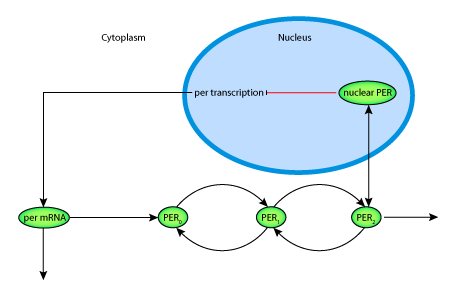
Fig: PER protein molecular structure (credit)
This question's answer was given by this year's Nobel laureates who had been studying about these fruit flies. They focused on how this clock actually works.After some hard work by these three Jeffrey C. Hall, Michael W. Young and Michael Rosbash , they found out the PER which is a protein encoded by period gene accumulated in the night time and was gradually degraded in the day time. Conclusively, PER protein levels is a one that keeps oscillating over a 24 hours period or cycle synchronizing with the circadian rhythm.
Mechanism of self-regulating biological clock
Another goal is to understand how does the circadian oscillations generate and is supportive. In a experiment done by Jeffrey Hall and Michael Rosbash hypnotized mentioning that the PER protein blocks the period gene activity. Reason behind it was that it had an inhibitory feedback loop where a PER protein can prevent its own synthesis and maintain its own level in a circadian cycle or continuous cycle.
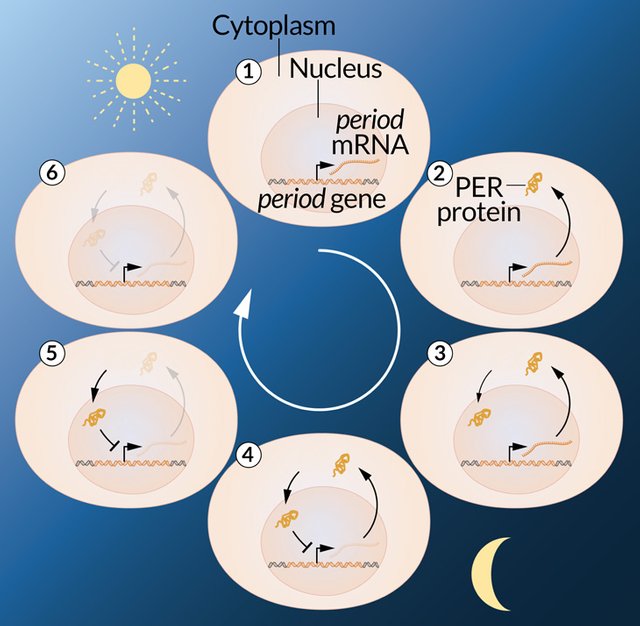
Fig: Feedback regulation of a period gene (credit)
The above figure shows on a 24 hours cycle oscillation. So, when a period gene is active, making of period mRNA is done. It then subsequently transported to the cytoplasm of the cell and serves as a template for the further production of PER protein. After its production, it builds up in the cell's nucleus and gives a blockade to the period gene .This blockade gives a rise to the inhibitory feedback mechanism that has been underlined with the circadian rhythm.
Stated as PER protein builds up in a cell during night . But how did it get there ?
Stated by the Michael Young , there is a second clock gene known as timeless, which encodes a protein called as TIM protein required for the normal circadian rhythm. He showed that both the TIM bound with the PER protein were able to enter the nucleus of a cell where they were able to block the period gene activity in closing the inhibitory feedback loop.
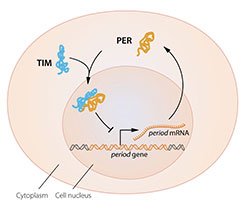
Fig: Simple Molecular Components of a circadian clock (credit)
After this regulatory feedback mechanism explained, a question still raised on how the oscillation of cellular protein levels occurred ? Then Michael Young identified another gene known as doubletime, which encodes a DBT protein which makes the delaying of the building up PER protein. This provided an insight for how an oscillation is occuring for a 24 hours cycle.
Some pattern of discoveries by the Nobel laureates kept formulating a mechanistic principles for the inner biological clocks.In the past few years, there have been much discoveries on other molecular components of the biological clock by explaining its functions and instabilities.
A circadian clock timekeeper in human physiology
So, the biological inner clock has been involved in many of the aspects controlling our complex physiology. We now know that the mechanism involved by the circadian rhythm in multicellular organism like plant, animals and other living organisms as human is all same.A huge amount of gene is regulated by this clock and conclusively, a carefully oriented circadian rhythm had adapted our physiology for different works in the stages of a day. These three scientist thus has provided some knowledge on circadian rhythm which happens to be a vast and highly researched field. Congratulations !
This is all for today steemians. Hope to see you on other health post. Thanks for a view !
With love,
khatisam4
Posting about the stuffs on math/engineering/technology/science articles, you are welcome to use the #steemSTEM tag for you post. It can give a help in promoting this tag as well as proving some knowledge to the Steemians using this tag. For more info please do visit the Steemit chat channel : steemit.chat/channel/steemSTEM

Reference Used:
(1) http://www.medscape.com/viewarticle/886390
(2)https://www.nobelprize.org/nobel_prizes/medicine/laureates/2017/press.html
Other Health Post:
(1) Henry Heimlich develop "Heimlich Maneuver" for emergency condition of choking
(2) "Good" cholesterol might actually be bad - High Density Lipoprotein
(3) "Game Changing vaccine" - HIV vaccine trial launched by the South Africa ! - Himal-Health-Contest #4
(4) Fibrodysplasia Ossificans Progressiva rare disorder - " Stone Man Syndrome "
(5) Surprisingly ,Human and zebrafish matched with mato cells of brain !
Great post and I wish steemit had a sticky or pin option because this is one of those special posts. ??
Thanks @drawing-go for your compliments !
This is an amazing post! I actually learned something from reading it! :)
Glad you liked it sir ! Thanks for the read :)
I agree!
This post has received a 0.45 % upvote from @drotto thanks to: @banjo.
They really deserve it lots or research and hard work they have put in thanks for explaining about it :)
i hope you follow or vote me